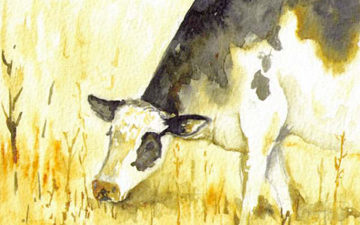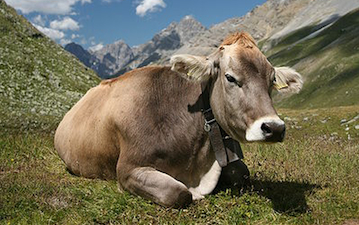Cattle (colloquially cows) are the most common type of large domesticated ungulates. They are a prominent modern member of the subfamily Bovinae, are the most widespread species of the genus Bos, and are most commonly classified collectively as Bos primigenius. Cattle are raised as livestock for meat (beef and veal), as dairy animals for milk and other dairy products, and as draft animals (pulling carts, plows and the like). Other products include leather and dung for manure orfuel. In some countries, such as India, cattle are sacred. It is estimated that there are 1.3 billion cattle in the world today.[1] In 2009, cattle became the first livestock animal to have its genome mapped.[2]
Cattle are ruminants, meaning that they have a digestive system that allows use of otherwise indigestible foods by regurgitating and rechewing them as “cud”. The cud is then reswallowed and further digested by specialised microorganisms in the rumen. These microbes are primarily responsible for decomposing cellulose and other carbohydrates into volatile fatty acids that cattle use as their primary metabolic fuel. The microbes inside the rumen are also able to synthesize amino acids from non-protein nitrogenous sources, such as urea and ammonia. As these microbes reproduce in the rumen, older generations die and their carcasses continue on through the digestive tract. These carcasses are then partially digested by the cattle, allowing them to gain a high quality protein source. These features allow cattle to thrive on grasses and other vegetation.
The gestation period for a cow is nine months. A newborn calf weighs 25 to 45 kilograms (55 to 99 lb). The world record for the heaviest bull was 1,740 kilograms (3,840 lb), a Chianina named Donetto, when he was exhibited at the Arezzo show in 1955.[28] The heaviest steer was eight year old ‘Old Ben’, a Shorthorn/Hereford cross weighing in at 2,140 kilograms (4,720 lb) in 1910.[29] Steers are generally killed before reaching 750 kilograms (1,650 lb). Breeding stock usually live to about 15 years (occasionally as much as 25 years).
A common misconception about cattle (particularly bulls) is that they are enraged by the color red (something provocative is often said to be “like a red flag to a bull”). This is incorrect, as cattle are red-green color-blind.[30][31] The myth arose from the use of red capes in the sport of bullfighting; in fact, two different capes are used. The capote is a large, flowing cape that is magenta and yellow. The more famous muleta is the smaller, red cape, used exclusively for the final, fatal segment of the fight. It is not the color of the cape that angers the bull, but rather the movement of the fabric that irritates the bull and incites it to charge.
Although cattle cannot distinguish red from green, they do have two kinds of color receptors in the cone cells in their retinas. Thus they are dichromatic, the same as most other mammals (including dogs, cats, horses and up to ten percent of male humans; see also color vision. ). They are able to distinguish some colors, particularly blue from yellow, in the same way as most other non-primate land mammals.[32][33]
(From Wikipedia.org, September 23 2010)





